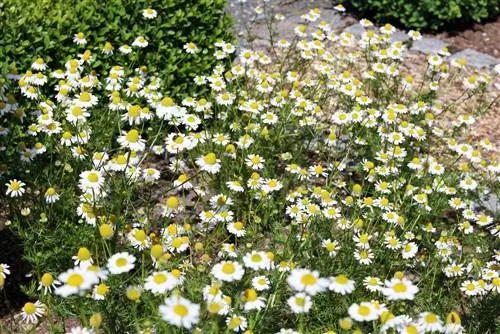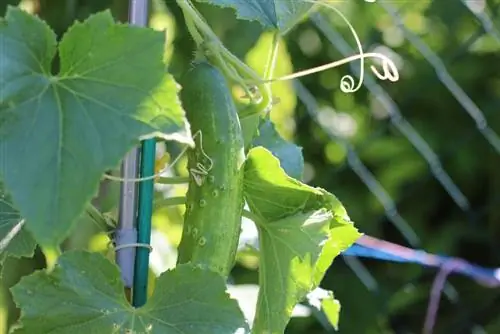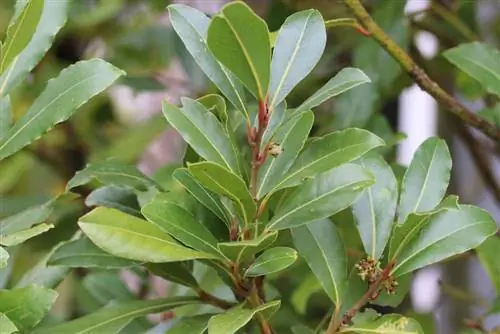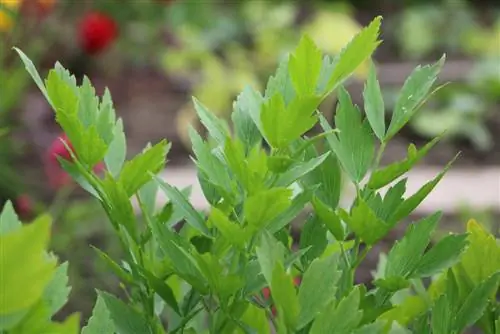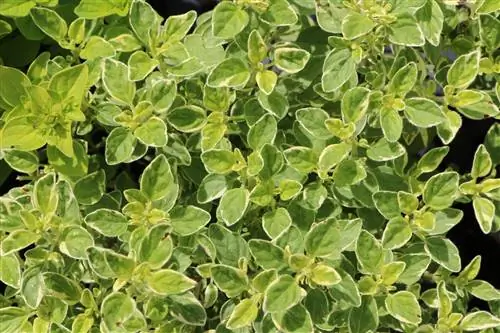- Author admin [email protected].
- Public 2023-12-17 03:39.
- Last modified 2025-06-01 06:48.
As a well-known medicinal plant, real chamomile is used for inflammation and stomach and intestinal problems. You get different seeds that differ according to the content of the active ingredients; For hobby gardeners, this aspect probably doesn't play a big role. You start sowing at the end of summer or beginning of autumn. Then the yield is greatest.
The real chamomile is an easy-to-care plant that can even survive the winter under certain conditions.
Profile
- Name: Real chamomile (lat.: Matricaria chamomilla)
- Family: Asteraceae (Latin: Asteraceae)
- Origin: Southern and Eastern Europe, Near East
- Sowing: end of August to beginning of September
- Flowering and harvest: September to October
- Growth height: 15 to 20 cm
- Use: herb, medicinal herb
- Special features: folded flower tongues, arched inflorescence
Location and soil conditions
The right place for sowing real chamomile is loamy, possibly slightly sandy soil that is well lit by the sun. Sowing in partially shaded places is also possible. For he althy growth, the place must be warm and moderately moist. The pH value of the soil may be in the slightly acidic to alkaline (basic) range and have a value between 6, 5 and 8. However, the location must not be too acidic, otherwise there is a risk of heavy metals being absorbed by the chamomile. If possible, the soil is nutrient-poor. Alternatively, you can choose black soil for growing chamomile. The soil condition at a glance:
- loamy, sandy soil
- sunny or partially shaded place
- Soil must be warm and only slightly moist
- ideal pH value between 6.5 and 8 (slightly acidic to slightly basic)
- alternatively use black earth
Sowing
Before you start sowing, pull out any weeds if necessary. Then loosen the soil until it has a fine, crumbly consistency. To make the soil even more suitable, enrich the soil with compost. The seeds of real chamomile are not buried and are not covered with soil after sowing; This plant is a so-called light germinator. The seeds only need to be pressed lightly after sowing. After about a week the first germs will begin to sprout. The steps of sowing in short:
- Be sure to pull weeds
- Loose the soil until it is finely crumbly
- If necessary, mix compost into the soil
- Sow seeds only on the ground and press lightly; do not cover with soil
- first seedlings after about a week
Wintering
Sowing before winter is not a problem. If the chamomile grows to such an extent that the small rosettes are already visible, the plant will survive the cold season without danger as long as it is protected from frost, for example by adding it a layer of straw. Problems can arise if there are cold times again next spring. The plant is not prepared for this climate change. The result is the lower growth of flowers in smaller numbers. Once the winter months are over, the seeds will mature into adult plants.
Pouring
The top priority is: Do not overwater. The real chamomile is only created for slightly moist soil, which is why watering is only necessary in moderation. Overall, however, a rather dry location is he althier for the plant than over-soaked soil. If you want to grow real chamomile in a container, you have to water it a little more than in the garden. It is advisable not to water the young plants with a watering can, but rather using a flower sprayer and a fine spray mist. Afterwards, only a small amount of water is necessary. If the cultivation of Matricaria chamomilla fails, it is most likely due to excessive watering.
Fertilize

The real chamomile is a he althy plant with only a few requirements. An intake of nutrients is only necessary in small quantities. If you decide to use nitrogen, you should only use it slightly, otherwise the herbs will grow excessively. The use of phosphorus runs under the same conditions as nitrogen. Much more important is fertilizing with potassium, which will allow the chamomile to bloom prolifically. But fertilizing is not a must. Gardeners who provide their chamomile plants with nutrient-rich soil may refrain from adding the nutrients. When it comes to real chamomile, the general saying is: less is more. This applies equally to water and fertilizer. The soil must therefore not dry out. If you decide to grow on sandy soil, fertilize with cattle dung pellets, as these are effective over a longer period of time.
- fertilize only a little
- Use nitrogen slightly, as well as phosphorus
- It is better to fertilize with potassium (ensures yields)
- There is no need to fertilize in nutrient-rich soil
- Cattle dung pellets on sandy soil because of long-acting time
Tip:
You can also sow real chamomile in conventional potting soil. However, this should be enriched with garden lime.
Blend
If you cut your plant, you only have to do this when sowing in the fall. As soon as the days get warmer, cut the plant into a slightly spherical shape. The more you cut the plant, the more flowers will grow back.
Harvest
It is important not to cut the first flower heads, as new flowers are constantly growing. It's worth waiting until the plants have fully developed their flowers. The yield is simply the greatest. The more advanced chamomile is in development, the lower the essential oil content is. If you want to use the oils of the medicinal plant, harvest the flower heads in good time. Otherwise, you shouldn't wait too long, otherwise the flower heads will fall apart. Even the stems can be harvested. This is particularly recommended if you want to make tea.
Tip:
It is best to harvest on a warm midday, as the flower heads are wide open at this time and contain plenty of essential oils.
Diseases
The real chamomile is robust, so there are no pests and diseases that threaten the entire sowing. Nevertheless, losses must be expected in an emergency. The most common is downy mildew, which is an infection of the leaves. Alternaria, a mold that causes stains, can also appear on the leaves of real chamomile. Large losses in yields can be attributed to the chamomile beetle, because it eats the flower petals. Aphids, bugs and similar pests also pose a danger.
Frequently asked questions
The plant doesn’t grow - what happened?
The seeds may have been overwatered. As a fairly undemanding plant, real chamomile only needs a little water. Too much fluid prevents development.
Can you grow chamomile in a pot?
Yes, sowing in a container is possible. However, this requires more water supply than plants that grow in the garden.
What you should know about real chamomile in brief
- Chamomile usually grows in abundance on rubble and field edges and prefers open, nutrient-rich soil.
- It is relatively undemanding and has also proven itself on open, unprotected terrain.
- Chamomile is an annual and blooms from May to August, but it usually reproduces by dropping its flower heads.
- The entire plant can reach a height of 20-50 cm.
Location
- When growing chamomile, you should definitely keep in mind that sowing too early can cause the plants to sprout too tall.
- Therefore, warmer weather without frost is recommended for growing chamomile.
- Ideally, you should start sowing at the beginning of August.
- Chamomile prefers neutral to alkaline soils and locations that are not too moist, making it well suited for balcony or bed cultivation.
Sowing
- The advantage of sowing in August is that you can produce the most productive crops without taking the risk of overwintering.
- Spring cultivation, ideally in April, generally means that you will generally be able to enjoy significantly more individual flowers.
Depending on the type of sowing, different things need to be taken into account. On the one hand, it is possible to leave the plant heads left over from the previous year in the bed or to graft them onto the desired location for renewed cultivation, which is equivalent to natural propagation. This type of cultivation has the advantage that it is less time-consuming than growing from seeds. The flowers don't blow away as quickly as the seeds, but if you want to use the flowers and their healing properties, a different sowing method is required. Seed mixtures are available commercially, the cultivation of which is described below.
- Before sowing, the bed should be freed from residues from previous sowing or harvesting and divided into fine grooves.
- A distance of approx. 30-35 cm between the individual plants is recommended.
- The planted seeds should be pressed lightly, but without covering them with soil, as chamomile is a light germinator.
- Germination occurs within a week if the weather is appropriate.
Care and Use of Chamomile
- Chamomile also thrives in relatively nutrient-poor soils, which often makes the addition of fertilizer unnecessary.
- Mixtures containing nitrogen in particular lead to unsightly growths.
- Chamomile is not susceptible to many diseases, but occasionally powdery mildew or fungi can occur on the roots.
- In this case, the affected plant should be disposed of in isolation.
In addition to aphids, there are also infestations with chamomile beetles, which eat the flower heads. For he althy growth and a productive harvest, the following tips should be followed:
- Never overwater chamomile. The soil should be maximally moist, but never wet.
- If the crop is about hand-high, it is worth using a machine hoe to prevent weed infestation.
- When the flower is two-thirds open, it is time to harvest.
- For optimal results, the harvest is dried at 35 to 45 °C and then sieved.
- Store the dried flowers in dry rooms!
- Use the chamomile flowers as a tea or to extract essential oils and to relieve inflammation, cramps or stomach pain.
Attention:
Chamomile can cause allergies!

